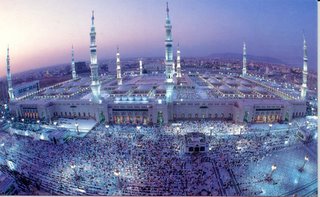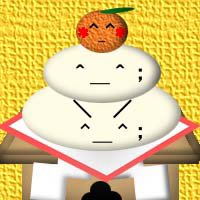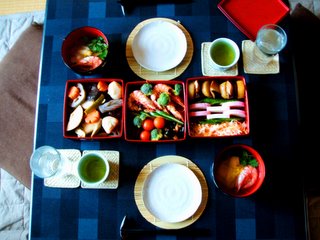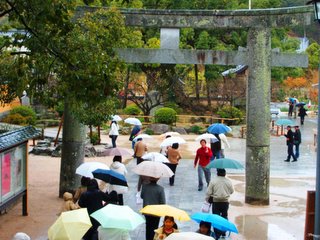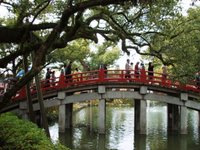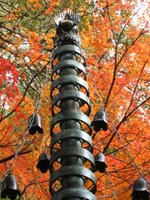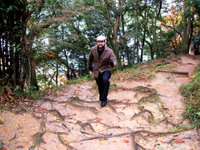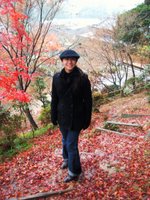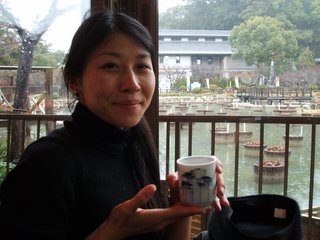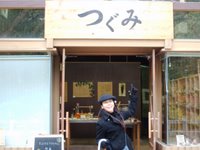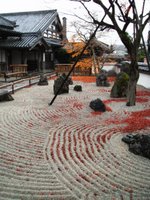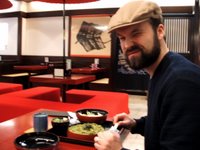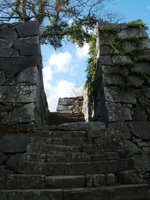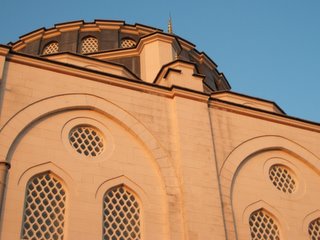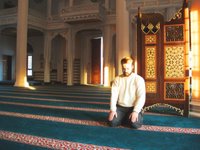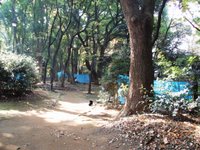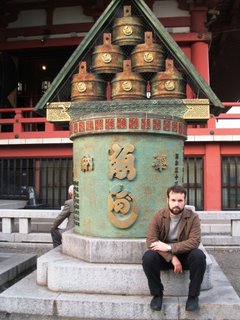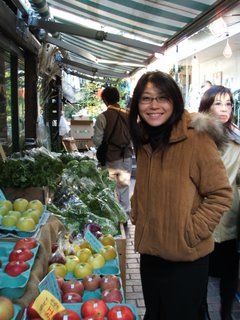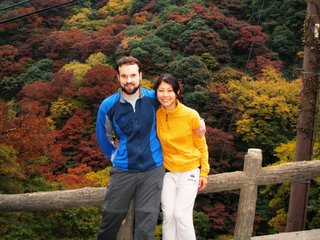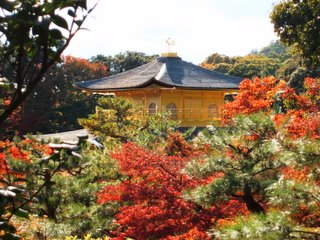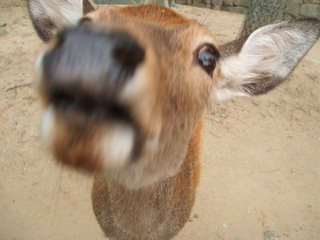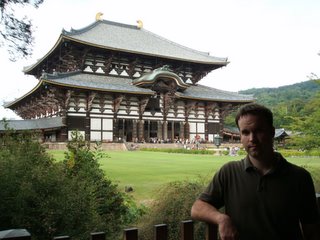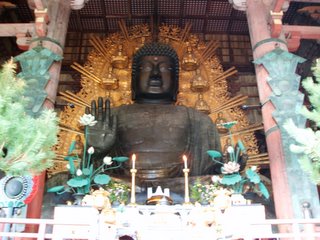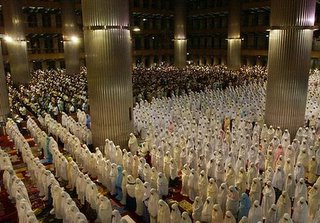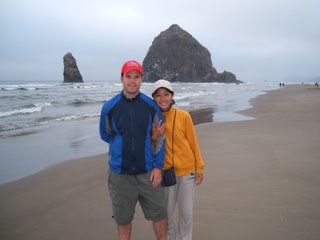 Out of the interest of time, we spent the second day of our trip in Miyajima, an hour train ride outside the city (a separate entry that will appear shortly). Upon our return to the museum to visit the west wing and the rest of Peace Memorial Park, I was anticipating another emotional rollercoaster. Knowing how quickly the time passed during our initial visit, we quickly passed by that which we had already viewed. We did, however, want to make a stop at the bookstand. Available were an abundance of books for both children and adults on a variety of topics relating to the nuclear issue and WWII. I left with three titles; two on Hiroshima: The Spirit of Hiroshima, published by the museum, and a children’s book, The Story of Barefoot Gen, about a Japanese family who opposed the war and were ostracized as a result but nonetheless held firmly to their believes despite outside threats. The third title: A Different Kind of Nuclear War: Children of the Gulf War, highlighting the cancerous effects of depleted uranium, used by the US armed forces to strengthen the piercing power of conventional ammunition. Although prohibited by international law as of 1998, having been classified as a weapon of mass destruction in 1996 for its devastating effects on populations living in the areas where it was used years after the fact, it continues to be used on the battlefields of Iraq. After purchasing too few books we made our way to the next exhibit.
Out of the interest of time, we spent the second day of our trip in Miyajima, an hour train ride outside the city (a separate entry that will appear shortly). Upon our return to the museum to visit the west wing and the rest of Peace Memorial Park, I was anticipating another emotional rollercoaster. Knowing how quickly the time passed during our initial visit, we quickly passed by that which we had already viewed. We did, however, want to make a stop at the bookstand. Available were an abundance of books for both children and adults on a variety of topics relating to the nuclear issue and WWII. I left with three titles; two on Hiroshima: The Spirit of Hiroshima, published by the museum, and a children’s book, The Story of Barefoot Gen, about a Japanese family who opposed the war and were ostracized as a result but nonetheless held firmly to their believes despite outside threats. The third title: A Different Kind of Nuclear War: Children of the Gulf War, highlighting the cancerous effects of depleted uranium, used by the US armed forces to strengthen the piercing power of conventional ammunition. Although prohibited by international law as of 1998, having been classified as a weapon of mass destruction in 1996 for its devastating effects on populations living in the areas where it was used years after the fact, it continues to be used on the battlefields of Iraq. After purchasing too few books we made our way to the next exhibit.The west wing is accessible via a long, somewhat claustrophobic sky bridge, with small square windows placed just below eye level, so that one had to crouch down slightly to look out, and walking on what sounded like a hollow floor we approached the other side. As we walked around the dark corner of the corridor we entered what resembled a nuclear war zone; crumbling brick walls,
 shattered glass and human replicas emerging from the fiery wreckage, their skin dripping from their bones like wax melting down a candlestick, the result of the intense heat of the nuclear reaction. This re-enactment, as it were, demonstrated the immediate experience of the blast- these victims, of course, were beyond hope for survival. In this area were also clothes worn by school children that dreadful day, burned and tattered. Most of them died a slow, painful death. Also on hand were articles that they had in hand on their way to school that morning. One that sticks out in my mind was a lunchbox that looked as though it had been excavated from a few feet of earth. The outside was clean but the inside revealed what appeared to be a dirty, rust covered clump of dirt; actually it was a child’s lunch that his mother had prepared, having been burnt to a crisp by the same heat that charred his skin.
shattered glass and human replicas emerging from the fiery wreckage, their skin dripping from their bones like wax melting down a candlestick, the result of the intense heat of the nuclear reaction. This re-enactment, as it were, demonstrated the immediate experience of the blast- these victims, of course, were beyond hope for survival. In this area were also clothes worn by school children that dreadful day, burned and tattered. Most of them died a slow, painful death. Also on hand were articles that they had in hand on their way to school that morning. One that sticks out in my mind was a lunchbox that looked as though it had been excavated from a few feet of earth. The outside was clean but the inside revealed what appeared to be a dirty, rust covered clump of dirt; actually it was a child’s lunch that his mother had prepared, having been burnt to a crisp by the same heat that charred his skin. There were artifacts of all sorts to be viewed. Many were ordinary items, including roof tiles and cement Buddhist statues resembling the infant figure displayed at the bank, their surfaces blistered. There were warped bottles and ceramic tea cups that had been bound together by intense heat. Accompanied by a rusted out tricycle, caked with soil,
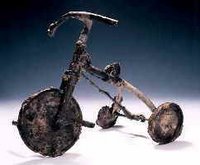 was one families story of Shin, their three year old child who fell victim to the bomb. Having been unable to save Shin’s sisters, his parents managed to pull him out from under the beams that had collapsed over him as he rode his tricycle in circles in the back yard. They rushed him to the river to try to quell his burns but without success; he died during the night.
was one families story of Shin, their three year old child who fell victim to the bomb. Having been unable to save Shin’s sisters, his parents managed to pull him out from under the beams that had collapsed over him as he rode his tricycle in circles in the back yard. They rushed him to the river to try to quell his burns but without success; he died during the night.  With no decent means for proper burial, his father dug a hole in the backyard where the child used to enjoy riding, and buried Shin along with the trike he so cherished. Forty years later, his mother convinced the father to raise their children’s bodies and place them in a more appropriate grave. As they were uncovering Shin’s “little bones”, they found his tricycle and donated it to the museum. One rather interesting display was a section of a cement wall, punctured by quarter sized piece of shattered glass, demonstrating the immense power released from the blast. Another large display, featuring of section the step, taken from the front of the bank, was inked with the shadow of a man who sat outside, waiting for the doors to open, unaware of what was about to occur in a few moments. The gamma rays from the bomb were so powerful that the flash produced a camera- like effect, casting permanent shadows on the ground. Considering all 42 employees were killed instantly within the thick concrete walls of the building, the customer waiting outside evaporated on impact.
With no decent means for proper burial, his father dug a hole in the backyard where the child used to enjoy riding, and buried Shin along with the trike he so cherished. Forty years later, his mother convinced the father to raise their children’s bodies and place them in a more appropriate grave. As they were uncovering Shin’s “little bones”, they found his tricycle and donated it to the museum. One rather interesting display was a section of a cement wall, punctured by quarter sized piece of shattered glass, demonstrating the immense power released from the blast. Another large display, featuring of section the step, taken from the front of the bank, was inked with the shadow of a man who sat outside, waiting for the doors to open, unaware of what was about to occur in a few moments. The gamma rays from the bomb were so powerful that the flash produced a camera- like effect, casting permanent shadows on the ground. Considering all 42 employees were killed instantly within the thick concrete walls of the building, the customer waiting outside evaporated on impact. Aside from remnants left in the wake of the atomic bomb were also aftershocks that continue to reverberate through Hiroshima. On display
 were photos of burn victims, their skin scorched and raw, bandaged in puss drenched rags, in addition to removable tissues such as hair and disfigured fingernails. Preserved by taxidermy was a malignant tongue, twisted and abscessed, from a soldier who contracted cancer after radiation exposure. Other infected body parts were preserved in formaldehyde in a tasteful but disturbing manner.
were photos of burn victims, their skin scorched and raw, bandaged in puss drenched rags, in addition to removable tissues such as hair and disfigured fingernails. Preserved by taxidermy was a malignant tongue, twisted and abscessed, from a soldier who contracted cancer after radiation exposure. Other infected body parts were preserved in formaldehyde in a tasteful but disturbing manner. Among the final exhibits were further scientific explanations of radiation’s harmful effects. Some people ask how it that Hiroshima is not still saturated with it. Apparently the residual radiation dissipated quickly, leaving only 20% by the next afternoon. Nowadays Hiroshima’s levels of radiation are no greater than a city that hasn’t had a nuclear accident. In other words, it’s not a Hanford or Chernobyl, despite being exposed to an actual atomic explosion. The last stretch featured testimonials and drawings from the survivors. After reading them, we made our way through the park.
The park’s center feature is the Peace Arch, dedicated to honoring the souls lost to the bomb.
 Beneath the austere structure is a vault containing names of more than 226,870 bomb related deaths, 79 volumes deep- many having perished decades after the attack; included are Chinese and Koreans who were enslaved by the army as well as the American prisoners of war also among the dead.
Beneath the austere structure is a vault containing names of more than 226,870 bomb related deaths, 79 volumes deep- many having perished decades after the attack; included are Chinese and Koreans who were enslaved by the army as well as the American prisoners of war also among the dead. 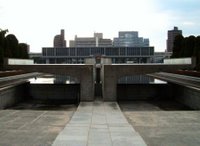 We offered our prayers of mercy for the fallen. Beyond the arch burns the Flame of Peace in remembrance of those whose thirsts could not be quenched while also serving as a sign of solidarity against nuclear weapons, aflame “until the day when all such weapons shall have disappeared from the earth."
We offered our prayers of mercy for the fallen. Beyond the arch burns the Flame of Peace in remembrance of those whose thirsts could not be quenched while also serving as a sign of solidarity against nuclear weapons, aflame “until the day when all such weapons shall have disappeared from the earth."A recent addition to the park is the Hiroshima National Peace Memorial Hall for the Atomic Bomb Victims, dedicated as both a memorial and educational and research center. Walking down into its modest spiraling pathway each step could be heard as if we were inside an empty tomb. The info guides provided, written in several languages, allowed us to access the personal memoirs of the victims, most containing an image as well, are an indispensable primary resource. Included is a library, featuring documentation and videos, related to the victims and their city. It’s shameful that the United States doesn’t have it’s own such research center but would rather keep it’s citizens in the dark, redirecting the funds toward promoting military recruitment in high schools and maintaining an aggressive, pre-emptive foreign policy.
Yet another sullen testament to the dead is the Memorial Mound, housing the ashes of more than 70,000 people. In a rush to rid the city of
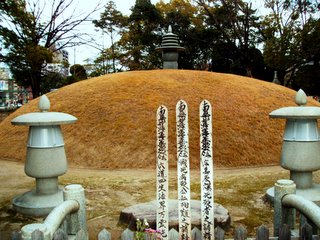 decomposing corpses, bodies were dragged from the streets and rivers to an area in the northern area of the park and cremated. Many of the ashes have been reclaimed over the years and given an individual burial but since many of the victims consisted of entire families, some were simply impossible to identify under the conditions at the time. Upon the mental images of piled bodies and the smell of burning flesh that must have enveloped the area, seeing the mound was enough to make the most callous of generals weep. Again, we offered our solemn prayers of mercy to those whose ashes were buried underneath the mound of earth that rose before us.
decomposing corpses, bodies were dragged from the streets and rivers to an area in the northern area of the park and cremated. Many of the ashes have been reclaimed over the years and given an individual burial but since many of the victims consisted of entire families, some were simply impossible to identify under the conditions at the time. Upon the mental images of piled bodies and the smell of burning flesh that must have enveloped the area, seeing the mound was enough to make the most callous of generals weep. Again, we offered our solemn prayers of mercy to those whose ashes were buried underneath the mound of earth that rose before us. As if to release our sorrow, we approached the steps leading to the Peace Bell, housed under
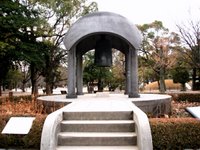 steep domed rooftop supported by four cylinder columns, modestly constructed. Carved into the surface of the bell is a map without artificial boarders, meant to symbolize “one world” reminding me
steep domed rooftop supported by four cylinder columns, modestly constructed. Carved into the surface of the bell is a map without artificial boarders, meant to symbolize “one world” reminding me of the words of John Lennon, “imagine there’s no countries.” We each took a turn at pulling back on the wooden plank, letting go and striking the bell. With each pound, a soft echo rang throughout the park; a soothing, comforting sound. Each August, on the anniversary of the bomb, several bells are rung to commemorate the “One Hundred Sounds the Japanese People Wish to Preserve.”
of the words of John Lennon, “imagine there’s no countries.” We each took a turn at pulling back on the wooden plank, letting go and striking the bell. With each pound, a soft echo rang throughout the park; a soothing, comforting sound. Each August, on the anniversary of the bomb, several bells are rung to commemorate the “One Hundred Sounds the Japanese People Wish to Preserve.”Across the river stands the infamous Atomic Bomb Dome, twisted in ruin, appearing as if since untouched at first glance. Over the years reinforcement beams have been added to prevent its collapse. As with the Bank of Japan building, upon detonation everyone inside was killed instantly. It was there, just
 600 meters above, that the bomb was deton- ated. It looked as though the hammer of Satan had pounded the surrounding grounds, causing the earth to tremble and the bricks to fall, as if they’d never been cemented together. One of the few remaining buildings, once among the city’s most adored, initially named the Hiroshima Prefectural Commercial Exhibition Hall, its presence stirred up many painful memories among those who had survived. For twenty years, it merely remained as a condemned eyesore that many wanted dismantled. A city council vote upheld the decision to maintain the structure as a living example of the threat posed by nuclear weapons. In 1996, it was registered as a World Heritage Site, a controversial move that will surely continue to leave an imprint on the memories of all who travel there to see it.
600 meters above, that the bomb was deton- ated. It looked as though the hammer of Satan had pounded the surrounding grounds, causing the earth to tremble and the bricks to fall, as if they’d never been cemented together. One of the few remaining buildings, once among the city’s most adored, initially named the Hiroshima Prefectural Commercial Exhibition Hall, its presence stirred up many painful memories among those who had survived. For twenty years, it merely remained as a condemned eyesore that many wanted dismantled. A city council vote upheld the decision to maintain the structure as a living example of the threat posed by nuclear weapons. In 1996, it was registered as a World Heritage Site, a controversial move that will surely continue to leave an imprint on the memories of all who travel there to see it. Having made my afternoon prayers nearby, we ended our tour of Memorial Peace Park. Though my account may seem like a grim one, I encourage everyone to who travels to Japan to make this important stop. The exhibits are tastefully and objectively displayed. In fact, I was surprised to see that the strict militarism of the Japanese was held also held accountable for what happened. They were, after all, seeking to dominate the South Pacific and large portions of the Asian
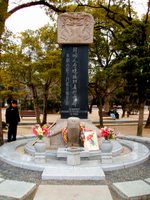 continent, something western imperial powers were not willing to allow. The Japanese Army was no doubt a vicious occupier of Taiwan, Korea, the Philippines, Indonesia, Singapore, and other areas, to be sure. Koreans were enslaved by the army and forced to endure rape and hard labor while looking down the barrel of a gun. In their own country, they were forbidden to use their native language, something that the current government in Tokyo is now writing out of the textbooks, along with the rape of Nanking, China, as if it never happened, furthering mutual resentment. The Korean victims of the atomic bomb were also denied reparations received by Japan from the United States- the memorial pictured didn't even become part of the park's landscape until 1999, despite the 50,000 who were killed.
continent, something western imperial powers were not willing to allow. The Japanese Army was no doubt a vicious occupier of Taiwan, Korea, the Philippines, Indonesia, Singapore, and other areas, to be sure. Koreans were enslaved by the army and forced to endure rape and hard labor while looking down the barrel of a gun. In their own country, they were forbidden to use their native language, something that the current government in Tokyo is now writing out of the textbooks, along with the rape of Nanking, China, as if it never happened, furthering mutual resentment. The Korean victims of the atomic bomb were also denied reparations received by Japan from the United States- the memorial pictured didn't even become part of the park's landscape until 1999, despite the 50,000 who were killed. Reconstructing a laundry list of war crimes committed by Japan would be an easy task. In so doing, however, one should take into consideration the fact that had Japan, or Germany, for that matter, dropped the bomb, the act would have indeed been considered a war crime, as Leo Szilard, one of the leading scientists who helped to develop the atomic bomb later noted. Those whose heads were hung at the close of the Nuremburg Trials, largely were condemned for acts of aggression, something every single US Head of State has been guilty of, including George W. Bush. As long as we’re the victors over our enemies, we’ll never be held to account, just as the Allied Powers of WWII were exempt from the trials at Nuremburg, though obvious atrocities were committed.
As we returned to our hotel in preparation to board the train back home, I paid my final respects to a city that I will always consider to be the most important of all I have visited in Japan, I hope to someday return with my children, insha’Allah. As long as this entry wound up being, it is far from completion. To give an adequate account would mean writing a book. There were many sites that I overlooked or didn’t have the time to visit. It’s those reasons that bring us back years later. Such visual reminders help us to maintain or open our eyes to the sick reality of modern warfare, which would have been condemned by any prophet of God. Seeing that Muhammad, peace be upon him, was the last in the prophetic succession, it should be recognized that he forbade the killing of civilians, now dubbed “collateral damage.” Also prohibited was the use of fire, the poisoning of crops and animals- though admittedly one wouldn’t know it by those carrying out such attacks in the name of Islam, but neither would Christ, peace be upon him, have blessed the slaughter committed by the crusaders or the war currently raging in Iraq, killing thousands.
Obviously I’ve made my position clear in regards to whether or not the use of the bomb was justified. I’ve listened to the argument that “the Japanese were ready to fight to the death,” and so it had to be done to save lives. Of course they were ready to fight to the death; that’s the essence of war. That aside, General Douglas Macarthur said a military justification to the use of the atom bomb didn’t exist. General Dwight D. Eisenhower likewise stipulated that the Japanese had already been virtually defeated, making the bomb absolutely unnecessary. As a teacher of history, I’ve yet to see these testimonials printed in any state issued high school textbook, again demonstrating the arrogance of the victors. It’s much easier to erect a Holocaust Museum to honor the victims of the Nazis than it is to recognize one’s own crimes against humanity. The fact that there exists no such grand memorial to pay tribute to the tribes who were exterminated to make way for the settlement of the western frontier nor one to recognize the tens of millions who were forced into the bowels of slave ships and worked to death building the mighty American Empire, testifies to the hypocrisy of nations. Until the perpetrators of crimes against humanity can admit their own guilt, much like the Germans were forced to do after WWII, as did later the South Africans during the Truth and Reconciliation Commission, at the close of Apartheid, the embers of resentment will continue to smolder, rendering any real attempt towards peace impossible.

